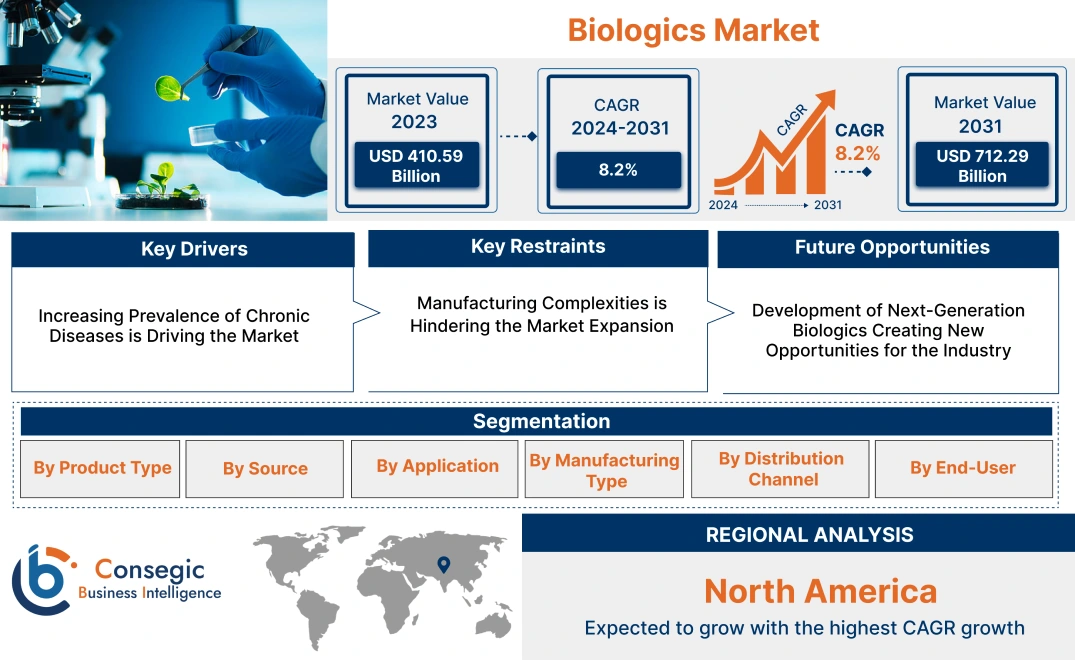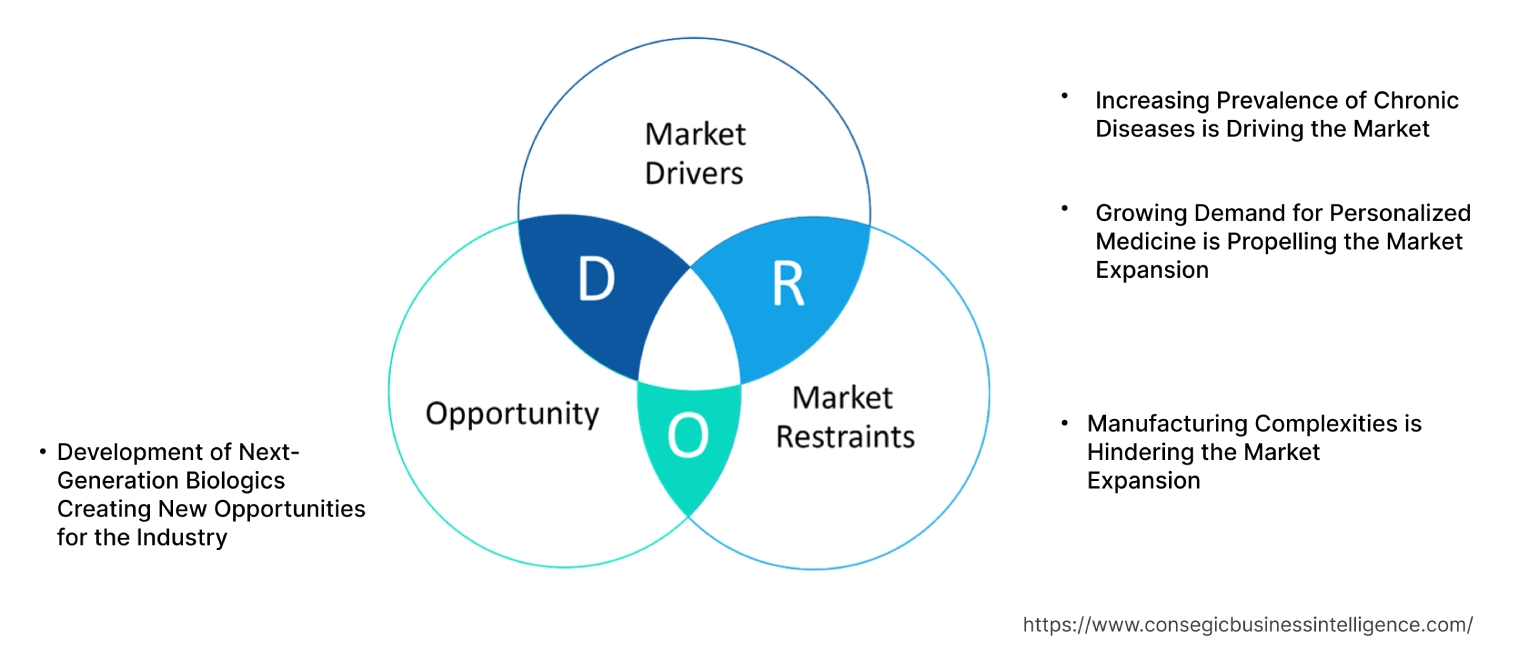Biologics Market Size:
Biologics Market size is estimated to reach over USD 712.29 Billion by 2031 from a value of USD 410.59 Billion in 2023, growing at a CAGR of 8.2% from 2024 to 2031.
Biologics Market Scope & Overview:
Biologics can also be referred to as biological products which are medical products that are developed from living organisms or are made of components that come from living organisms. They are indispensable in the management, detection, and control of numerous ailments including cancers, autoimmune diseases, infections, and scantily reported genetic diseases. They are generally more intricate compared to other conventional small molecule therapies and are made using biotechnology methods including recombinant DNA technology. In the market context, end users thus refer to all the different stakeholders in the use, distribution, or application of biological applications. For instance, healthcare service providers, patient advocates, pharmaceutical and biotechnology firms and organizations, and research centers.
Biologics Market Insights:
Key Drivers:
Increasing Prevalence of Chronic Diseases is Driving the Market
Long-term diseases like cardiovascular diseases, diabetes mellitus, cancers, autoimmune and chronic obstructive pulmonary diseases are prevailing continuously as a result of various causes like aging, behavioral and modifiable risk factors, and exposures to the environment. The incidence and prevalence of these diseases are on the rise, and as such there is a growing need for better treatment that cuts across the biologics. It includes monoclonal antibodies that offer unique therapeutic profiles for chronic diseases than conventional therapies since they are tailored to address disease processes and pathways. Biological agents like immune checkpoint inhibitors and CAR-T cell therapies have emerged that have significantly impacted the cancer treatment landscape. These therapies are intended to exploit the immune system's abilities to identify and destroy cancer cells, thus giving new hope for patients with different forms of cancer.
- In June 2023, Chronic inflammatory lung disorders are among the primary causes of death and considerable morbidity worldwide. Biologic medicines, particularly peptide inhibitors and monoclonal antibodies hold potential as treatments for chronic lung disorders.
Therefore, advances in biologics, coupled with the aging population and the strain on healthcare systems, are creating opportunities for innovative therapies that can address the growing burden of chronic diseases.
Growing Demand for Personalized Medicine is Propelling the Market Expansion
Personalized medicine, which tailors treatments to individual patient's characteristics such as genetic makeup, lifestyle, and disease profile, is increasingly influencing the development and adoption of biological therapies. Advances in genetic and genomic technologies allow for detailed profiling of patients' genetic information. This enables the development of biologics that are specifically designed to target genetic variations and mutations, improving treatment efficacy and reducing adverse effects. Advances in cell and gene therapies are enabling the creation of treatments customized to individual patient profiles. For example, CAR-T cell therapies involve modifying a patient's T cells to target cancer cells, providing a personalized approach to oncology.
- In March 2022, according to a Research Gate publication, developing precision medicine has become a great interest among researchers lately as they helps to treat monogenic diseases that target specific molecules that cause cancer and eventually help to slow down its spread.
Therefore, as per the market analysis, the growing demand for personalized medicine is significantly propelling the biologics market growth due to the advances in genetic and genomic technologies and the development of targeted biologics.
Key Restraints :
Manufacturing Complexities is Hindering the Market Expansion
The market has factors that create challenges which, translates to effects on the progress, manufacture, and supply of biologic therapies that put limitations on the market. Special biological manufacturing from the concept stage to the industrial level is intricate and costly. It entails significant capital investment in plants, equipment, and various process improvements. The optimization of a manufacturing process to provide an enhanced, low-variation product is crucial and can be an arduous process of fine-tuning. Manufacturing biologics entails the use of equipment and infrastructure known as bioreactors, chromatography systems, and aseptic processing. These consistencies and uses require a lot of capital and engineering to keep and run the equipment.
- In March 2024, biologics which include gene treatments, cell-based medicines, and monoclonal antibodies present considerable challenges due to their intrinsic variability, complex regulations, and intricate products.
Therefore, high production costs, regulatory compliance, technical and process challenges, supply chain management, intellectual property issues, talent shortages, and environmental concerns play an important role in constraining biologics market demand.
Future Opportunities :
Development of Next-Generation Biologics Creating New Opportunities for the Industry
The market is expected to change more in the future with the emergence of the new generation of biologics due to technology, advanced disease understanding, and the requirement for better and targeted drugs. A better understanding of RNAi and mRNA has led to the development of new biological drugs that will either act as antisense or functional RNA sequences to treat diseases. The creation of bispecific antibodies, which will be able to fix at the same time with two different antigens, is another potential for creating more effective immunotherapies for cancer and other complex diseases.
- In 2024, Pharma Tech stated that the field of biological therapeutics has witnessed a substantial expansion and development, mostly driven by advances in molecular and cellular biology. It has the potential to improve the efficacy, half-life, stability, and specificity of biological medicines while minimizing side effects.
Therefore, as per the market analysis, the development of next-generation biologics represents a dynamic and rapidly evolving field with numerous biologics market opportunities.
Biologics Market Segmental Analysis :
By Product Type:
Based on product type, the market is segmented into Monoclonal Antibodies (mAbs), Vaccines, Cell Therapy, Gene Therapy, Recombinant Proteins, Tissue-Based Products, and Others.
Trends in the Product Type:
- Innovations such as bispecific antibodies and antibody-drug conjugates are expanding the applications and effectiveness of monoclonal antibodies.
- International organizations such as the World Health Organization (WHO) and GAVI are working to expand vaccination coverage.
The monoclonal antibodies segment accounted for the largest revenue share of the total biologics market share in 2023.
- Monoclonal antibodies have become a cornerstone in cancer treatment, with drugs targeting specific tumor antigens, checkpoint inhibitors, and therapies aimed at modulating the immune system to fight cancer.
- Monoclonal antibody products like Rituximab (Rituxan), Trastuzumab (Herceptin), and Adalimumab (Humira) have been significant revenue generators.
- Advances in biotechnology have led to the development of new and improved monoclonal antibodies, including those with enhanced efficacy, reduced immunogenicity, and improved delivery mechanisms.
- For instance, the FDA approved LEQEMBI, a monoclonal antibody drug, via the Accelerated Approval Pathway for the treatment of Alzheimer's disease.
- Thus, the dominance of monoclonal antibodies in the market in 2023 reflects their significant impact and value in modern medicine.
The vaccine segment is anticipated to register the fastest CAGR during the forecast period.
- Recent breakthroughs in vaccine technology, such as mRNA vaccines, have demonstrated remarkable efficacy and speed in development. These advancements are paving the way for new and improved vaccines for various diseases.
- There is a heightened focus on preparedness for future pandemics, driving rapid vaccine development and deployment strategies.
- The expansion of vaccines beyond traditional infectious diseases to include vaccines for cancer, allergies, and other non-infectious conditions is driving the market.
- For instance, Pfizer initiated phase 3 trials for its mRNA-based flu vaccine. These advances emphasize the rising prospects for mRNA-based vaccinations in the medical realm.
- Thus, the vaccines segment is poised to register the fastest due to technological innovations, increased focus on preventive healthcare, and a global emphasis on managing infectious diseases, thus, in turn, driving the biologics market trends.
By Source:
Based on source the market is segmented into microbial, mammalian, and others.
Trends in the Source:
- Emerging applications of microbial systems in producing new types of biologics, such as personalized vaccines and gene therapies, are expanding the market.
- Automation and integrated bioprocessing systems enhance productivity and reduce costs associated with mammalian cell-based production.
The microbial segment accounted for the largest revenue of the biologics market share in 2023.
- Microbial components include biological products that are derived from or utilize microorganisms such as bacteria, yeast, or viruses.
- Many vaccines are produced using microbial systems. For example, vaccines for diseases like influenza, hepatitis B, and human papillomavirus (HPV) often rely on recombinant DNA technology using bacteria or yeast.
- The need for therapeutic proteins and vaccines to treat chronic and complex diseases drives microbial-based biologics.
- Global vaccination programs, including those against COVID-19 and other infectious diseases, often use microbial systems for vaccine production, significantly contributing to the revenue of this segment.
- For instance, according to WHO , biological therapies, often known as biologicals, are medications that are produced from large-scale cell cultures of bacteria, yeast, plants, or animal cells and then purified.
- Thus, the ongoing need and requirement for vaccines and therapeutic proteins, coupled with continued innovation and investment in microbial-based biologics makes it an important segment of the market. This, in turn, drives the biologics market demand.
The mammalian segment is anticipated to register the fastest CAGR during the forecast period.
- Mammalian cells are capable of producing complex proteins with proper post-translational modifications, which are essential for the efficacy and safety of many biological drugs. This includes therapeutic proteins like monoclonal antibodies, which require mammalian cell systems for proper glycosylation and folding.
- Advances in mammalian cell line engineering, such as CHO cell lines, have enhanced production efficiency and scalability, contributing to the segment.
- Monoclonal antibodies, which are predominantly produced using mammalian cells, are widely used in the treatment of various cancers and autoimmune diseases.
- For instance, KBI Biopharma is a reliable global partner for skilled mammalian-based biopharmaceutical development and production. Mammalian cell line creation services offer single-cell cloning technologies and many more.
- Thus, the mammalian segment is expected to register the fastest due to its ability to produce complex and high-quality biologics and technological advancements in cell line development and bioprocessing. This drives the biologics market trends.
By Application:
Based on application the market is segmented into Oncology, Immunology, Cardiovascular Diseases, Infectious Diseases, Neurology, Ophthalmology, Rare Diseases, and others.
Trends in the Application:
- The expansion of immuno-oncology, which involves harnessing the immune system to fight cancer, and treatments like PD-1/PD-L1 inhibitors and CAR-T therapies are leading this trend.
- Integration with digital health solutions, such as remote monitoring and telemedicine, enhances the management and accessibility of biologic treatments for cardiovascular conditions.
The Oncology segment accounted for the largest revenue share of 29.33% in 2023.
- Oncology, encompassing the treatment of various types of cancer, including solid tumors and hematological malignancies, requires advanced therapies.
- Biologics that target specific cancer cells or pathways, such as targeted monoclonal antibodies and tyrosine kinase inhibitors, are highly effective and have significantly improved treatment outcomes.
- Regulatory incentives, such as orphan drug designations and breakthrough therapy designations, support the development and commercialization of biologics for oncology.
- Thus, the oncology segment accounted for the largest revenue due to the high demand for advanced biologic treatments, and the increasing incidence of cancer. This drives the biologics market growth.
The Cardiovascular Diseases segment is anticipated to register the fastest CAGR during the forecast period.
- The prevalence of cardiovascular diseases, including coronary artery disease, heart failure, and arrhythmias, is rising globally due to factors such as aging populations, lifestyle changes, and increasing rates of obesity and diabetes.
- As cardiovascular diseases are often chronic and require long-term management, there is a growing requirement for advanced biologic therapies that can provide effective and sustained treatment.
- The market is expanding because of the introduction of novel biological treatments that target certain pathways implicated in cardiovascular illnesses, such as gene therapies and monoclonal antibodies.
- For instance, Jeffrey Isner's pioneering studies have used recombinant growth factors to transfer antigenic proteins to the heart in an attempt to generate angiogenesis as a treatment for myocardial ischemia. The goal has been to either induce bone marrow cell mobilization or exert cardioprotection.
- Thus, the focus on innovative treatments, regulatory support, and technological advancements further contributes to biologics market opportunities.
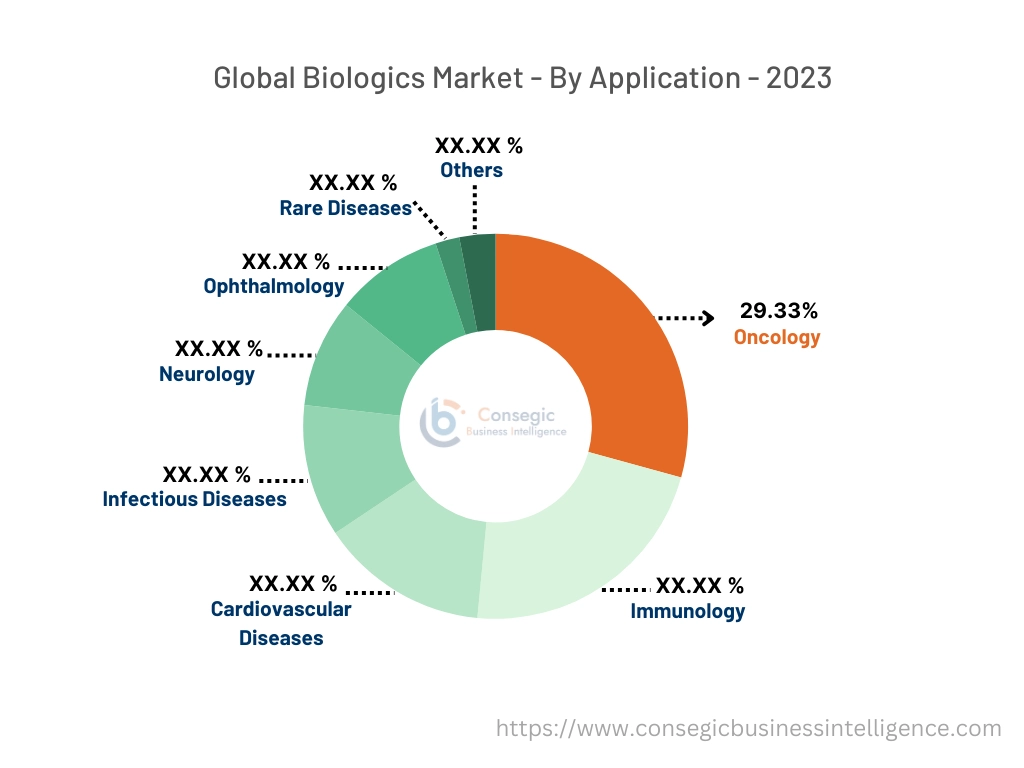
By Manufacturing Type:
Based on manufacturing the market is segmented into In-House Manufacturing and Outsourced Manufacturing.
Trends in the Manufacturing Type:
- The integration of automation and advanced manufacturing technologies in in-house facilities enhances efficiency, reduces human error, and improves production consistency.
- Significant technological advancements in single-use bioreactors have offered more efficient, scalable, and high-quality production services attracting more clients to outsource manufacturing.
The In-House Manufacturing component accounted for the largest revenue in the year 2023.
- In-house manufacturing allows companies to maintain stringent quality control throughout the production process, ensuring that biologics meet the highest standards for safety, efficacy, and consistency.
- By producing in-house, companies can better manage production costs, optimize resource allocation, and reduce reliance on external manufacturers, potentially lowering overall expenses.
- Innovations in biomanufacturing, such as single-use technologies and continuous production processes, are being implemented in in-house facilities to improve production scalability and reduce costs.
- For instance, WuXi Biotech provides in-house production, which provides one-stop cell banking, and cell line characterization services in compliance with international GNP norms.
- Thus, the In-House Manufacturing component accounted for the largest revenue due to the control it offers over production quality, cost efficiency, flexibility, and security.
The Outsourced Manufacturing component segment is anticipated to register the fastest CAGR during the forecast period.
- Outsourced manufacturing can help companies reduce operational costs related to labor, utilities, and raw materials by utilizing the expertise and resources of specialized contract manufacturing organizations.
- Outsourced manufacturing offers scalability and flexibility, enabling companies to adjust production volumes based on market demand without the need for significant capital investment.
- Outsourcing allows for diversification of the supply chain, reducing dependency on a single production site and mitigating risks associated with potential disruptions or facility issues.
- For instance, as per the Outsourcing Center the rise of industrial outsourcing is linked in large part to the advent of globalization. Businesses now access a global network of manufacturers and suppliers, encouraging cross-border collaboration and expanding their market reach.
- Thus, as companies continue to seek flexible and cost-effective solutions for production, outsourced manufacturing is poised to play a significant role in the evolving market.
By Distribution Channel:
Based on distribution channel the market is segmented into Hospital Pharmacies, Retail Pharmacies, and Online Pharmacies.
Trends in the Distribution Channel:
- The integration of hospital pharmacies with electronic health records and other digital health tools enhances the efficiency of biologic management and contributes to the revenue.
- The broader trend towards digital transformation and e-commerce is driving growth in online pharmacies.
The Hospital Pharmacies component accounted for the largest revenue in the year 2023.
- Hospital pharmacies are responsible for dispensing and managing complex biologic therapies, including monoclonal antibodies, immunotherapies, and biologics for severe chronic conditions.
- Hospital pharmacies have access to specialized equipment and facilities for the preparation and administration, ensuring their proper use and contributing to revenue generation.
- Hospital pharmacies adhere to stringent regulatory standards for storage and handling, which supports their use and revenue.
- Thus, as biologic therapies continue to advance and expand, hospital pharmacies are expected to maintain their prominent position in revenue generation within the industry.
The Online Pharmacies component segment is anticipated to register the fastest CAGR during the forecast period.
- Online pharmacies provide a convenient platform for patients to access biologics from the comfort of their homes. This convenience is particularly valuable for those managing chronic conditions or requiring regular treatments.
- The integration of online pharmacies with telemedicine services allows for a seamless process where prescriptions can be easily managed and filled online.
- Online pharmacies can offer competitive pricing and discounts, making it more affordable for patients and encouraging online purchases.
- For instance, prescription tracking and refill reminders are common services offered by online platforms, ensuring that patients receive their drugs on time, contributing to greater adherence and health outcomes.
- Thus, as per the segmental analysis, online pharmacies continue to evolve and expand, they are poised to play an increasingly prominent role in the market.
By End-User:
Based on end-user the market is segmented into Hospitals & Clinics, Pharmaceutical & Biotechnology Companies, Research Organizations, and others.
Trends in the End-User:
- The growth of outpatient infusion centers and day hospitals where biologics can be administered in a less intensive setting drives revenue and reflects a shift towards more flexible treatment environments.
- The rise of biotech startups focused on innovative biological therapies is contributing to the rapid growth of this segment.
The Hospitals & Clinics segment accounted for the largest revenue in the year 2023.
- Hospitals and clinics are primary settings for the administration of complex biologic therapies, such as monoclonal antibodies, biologic drugs for cancer, autoimmune diseases, and gene therapies.
- Biologics used in hospitals often involve advanced therapies that require specialized equipment, trained healthcare professionals, and precise administration, making hospitals and clinics the central hubs for these treatments.
- The use often involves multidisciplinary teams, including specialists, nurses, and pharmacists, contributing to the efficient administration and increased revenue from biologic therapies.
- Thus, the integration of biologics into hospital and clinic treatment plans, along with advancements in healthcare infrastructure and technology, contributes to their significant revenue generation.
The Pharmaceutical & Biotechnology Companies segment is anticipated to register the fastest CAGR during the forecast period.
- Pharmaceutical and biotechnology companies are heavily investing in research and development to develop new biological therapies, including monoclonal antibodies, vaccines, and cell and gene therapies.
- Technological advancements, such as high-throughput screening, next-generation sequencing, and improved biomanufacturing processes, are enhancing the capabilities of pharmaceutical and biotechnology companies to develop and produce biologics.
- For instance, BioRay Pharmaceuticals is a Chinese biopharma business that develops innovative antibody therapies and also focuses on discovering, developing, manufacturing, and commercializing medications for the treatment of immune-mediated disorders including cancer.
- Thus, as per the analysis, the strategic collaborations, regulatory support, and expansion into emerging markets further contribute to the rapid growth of this segment, making it a key driver in the market.
Regional Analysis:
The regions covered are North America, Europe, Asia Pacific, the Middle East and Africa, and Latin America.
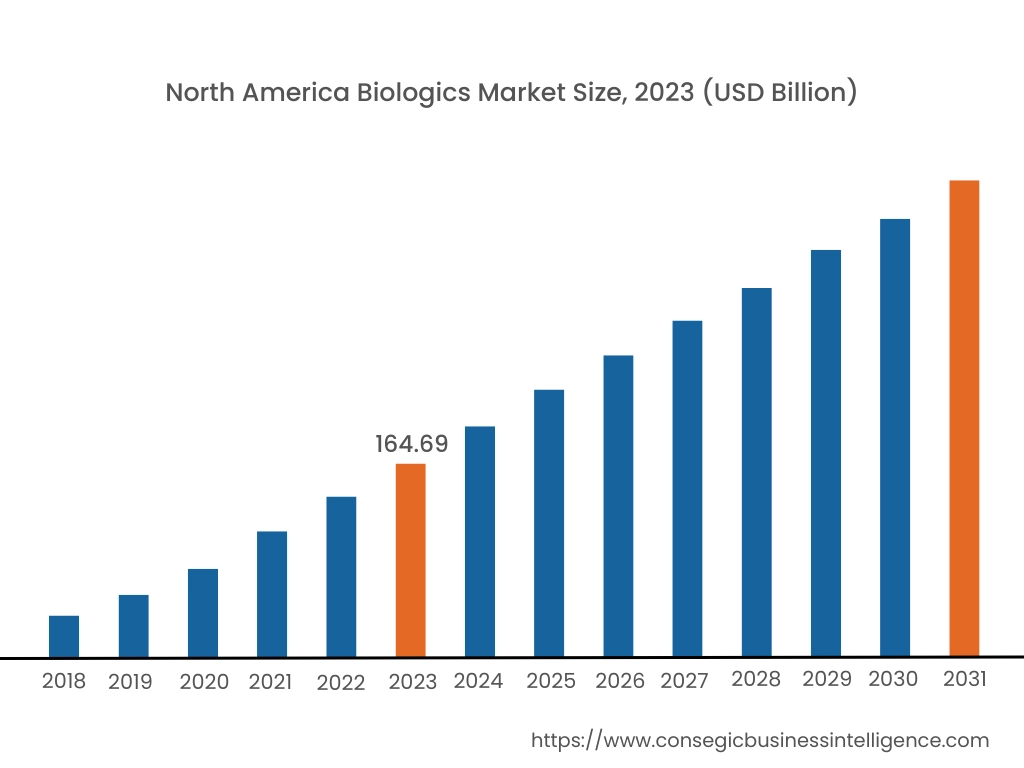
In 2023, North America accounted for the highest market share at 37.43% and was valued at USD 164.69 Billion. In North America, the U.S. accounted for the highest market share of 72.23% during the base year of 2023. As per the biologics market analysis, North America, particularly the United States and Canada, plays a crucial role due to its advanced healthcare infrastructure, high demand, and significant investment in biopharmaceutical research and development.
- In May 2024, Regulatory bodies, like the US Food and Drug Administration (FDA) and the European Medicines Agency (EMA), have set tough biosimilar approval standards. These guidelines ensure that biosimilars satisfy high standards for safety, efficacy, and quality, which builds trust among healthcare providers and patients.
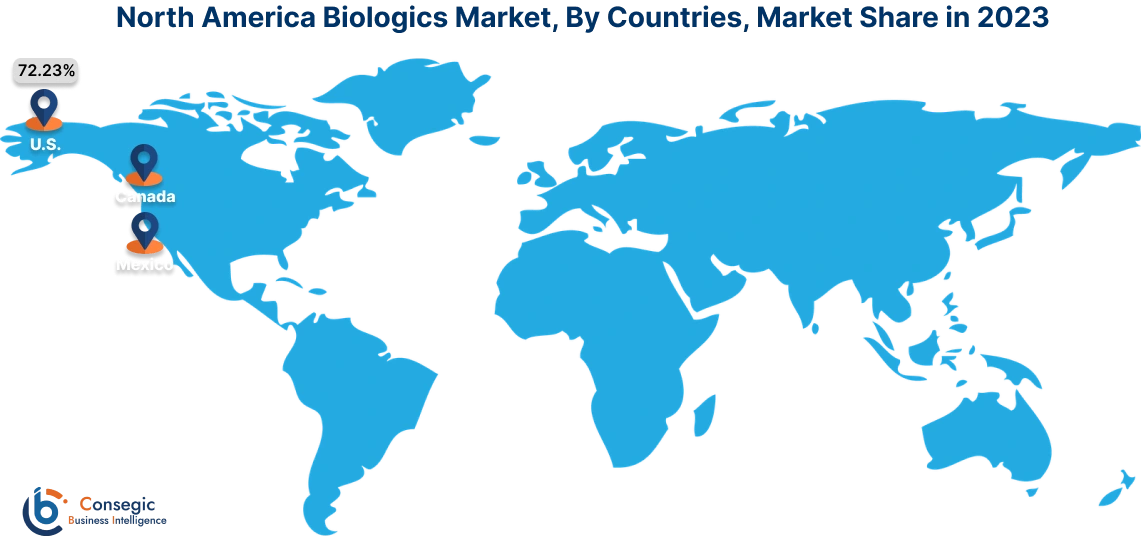
Asia Pacific is expected to witness the fastest CAGR over the forecast period of 9.1% during 2024-2031. Asia-Pacific region is rapidly emerging in the global biologics market with its diverse and expanding economies, growing healthcare needs, and increasing investments in biotechnology. Countries like China and India have established clear pathways for the approval of new biologic therapies and biosimilars, promoting market growth.
- In 2024, Albatroz Therapeutics a biotech startup researching therapeutic antibodies against a new target that destroys the extracellular matrix.
Europe is a prominent player in several advanced biomanufacturing and research facilities. Countries like Germany, Switzerland, and the United Kingdom are renowned for their high-quality production capabilities and innovative research in the market.
Middle East and Africa regions are investing heavily in healthcare infrastructure to improve access to advanced treatments. This includes building state-of-the-art hospitals, research centers, and biomanufacturing facilities for the biologics market expansion.
The biologics market analysis shows that in Latin America, there's a rise in the need for biopharmaceuticals, such as vaccines, insulin, monoclonal antibodies, and gene therapies for both chronic and infectious diseases. Countries like Brazil, Mexico, and Argentina are leading the expansion with many local companies developing biosimilars and biofuels.
Top Key Players & Market Share Insights:
The biologics market is highly competitive with major players providing products and services to the national and international markets. Key players are adopting several strategies in research and development (R&D), product innovation, and end-user launches to hold a strong position in the global biologics market. Key players in the biologics industry include –
- Pfizer Inc. (USA)
- Roche Holding AG Ltd. (Switzerland)
- Johnson & Johnson, Inc. (USA)
- Bristol-Myers Squibb Company (USA)
- Eli Lilly and Company (USA)
- AbbVie Inc. (USA)
- Amgen Inc. (USA)
- Novartis AG (Switzerland)
- Merck & Co., Inc. (USA)
- Sanofi S.A. (France)
Recent Industry Developments :
Partnerships and Collaborations:
- In July 2024, Evotec SE announced that its biologics division, Just - Evotec Biologics Inc., has strengthened its strategic partnership with Sandoz. This expanded partnership demonstrates Just-Evotec Biologics' commitment to providing Sandoz with a long-term commercial supply of biosimilars.
Mergers & Acquisitions:
- In June 2024, AstraZeneca, a worldwide pharmaceutical corporation, recently announced the acquisition of Fusion Pharmaceuticals, a clinical-stage biopharmaceutical startup, for USD 2.41 billion.
Product Development:
- In May 2024, Novumgen researchers are developing next-generation biologics with increased efficacy, less immunogenicity, and improved delivery systems. These improvements may result in more effective treatments with fewer side effects, benefiting patients with a variety of chronic and severe illnesses.
Biologics Market Report Insights :
| Report Attributes | Report Details |
| Study Timeline | 2018-2031 |
| Market Size in 2031 | USD 712.29 Billion |
| CAGR (2024-2031) | 8.2% |
| By Product Type |
|
| By Source |
|
| By Manufacturing Type |
|
| By Distribution Channel |
|
| By Application |
|
| By End-User |
|
| By Region |
|
| Key Players |
|
| North America | U.S. Canada Mexico |
| Europe | U.K. Germany France Spain Italy Russia Benelux Rest of Europe |
| APAC | China South Korea Japan India Australia ASEAN Rest of Asia-Pacific |
| Middle East and Africa | GCC Turkey South Africa Rest of MEA |
| LATAM | Brazil Argentina Chile Rest of LATAM |
| Report Coverage |
|
Key Questions Answered in the Report
How big is the Biologics Market? +
Biologics Market size is estimated to reach over USD 712.29 Billion by 2031 from a value of USD 410.59 Billion in 2023, growing at a CAGR of 8.2% from 2024 to 2031.
Which is the fastest-growing region in the biologics market? +
Asia-Pacific is the fastest-growing region in the biologics market.
What specific segmentation details are covered in the biologics market report? +
The specific segments that are covered in the biologics market report are product type, source, application, manufacturing type, distribution channel, and end-user.
Who are the major players in the biologics market? +
The major players in the biologics market are Pfizer Inc. (USA), Roche Holding AG Ltd. (Switzerland), Johnson & Johnson Inc. (USA), AbbVie Inc. (USA), Amgen Inc. (USA), Novartis AG (Switzerland), Merck & Co., Inc. (USA), Sanofi S.A. (France), Bristol-Myers Squibb Company (USA), and Eli Lilly and Company (USA)
